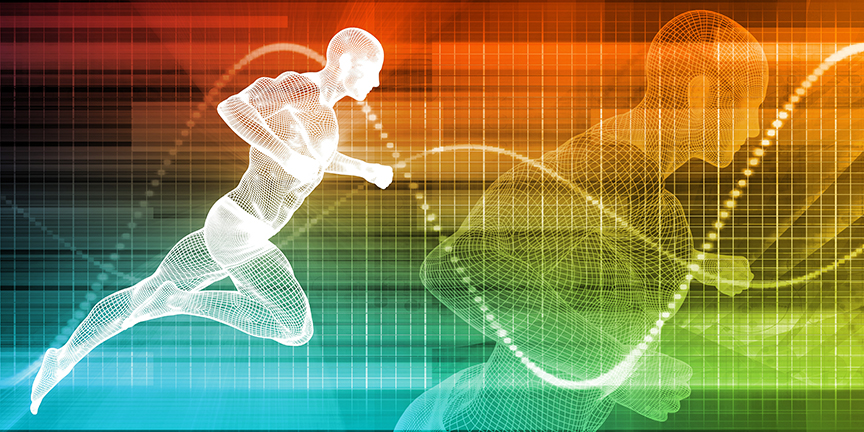
An American is injured on the job every seven seconds. Whether it’s loading freight
onto trucks, stocking warehouse shelves, or even back strain from an office chair,
an average of 12,600 workers are hurt each day – costing industry millions in dollars
and production days lost.
Would you believe a cell phone application could help prevent such injuries?
Ashish Gupta, Associate Professor of Business Analytics in the Harbert College of Business, created a mobile health application that analyzes a person’s injury risk. The program
-- Sports Injury Prevention Screening (SIPS) -- can be utilized by athletes to assess
their injury risk with its functionality, and it’s applicable beyond the playing fields.
 “We developed an Internet of Things (IoT) based application that utilizes sensors
within a cell phone that can be tied to the body while an athlete undergoes testing,”
Gupta said. “The phone collects the data through a variety of body movements such
as simple jumps and sway tests. The data is collected in milliseconds and is used
in conjunction with other data about the user to build a model that is context specific
to help prevent injuries.
“We developed an Internet of Things (IoT) based application that utilizes sensors
within a cell phone that can be tied to the body while an athlete undergoes testing,”
Gupta said. “The phone collects the data through a variety of body movements such
as simple jumps and sway tests. The data is collected in milliseconds and is used
in conjunction with other data about the user to build a model that is context specific
to help prevent injuries.
“We have developed machine-learning models that can make a prediction about that person’s
injury risk. Different tests are specific to certain types of injuries, including
extremities, the lower body and spinal injuries.”
Once provided with participant feedback, Gupta said athletic trainers had the opportunity
to practice players differently than they would have before to help further mitigate
the potential risk. If this works in the sports world, why not the corporate world
as well? “For large companies that involve manufacturing or packaging operations,
there can be a huge implication for this,” said Gupta, who plans to develop this work
further and conduct various experiments that will help fine-tune the Artificial Intelligence
models.
“This is an innovative cloud-based application that could provide a 360-degree view
of an athlete’s or employee’s injury risk that combines the principles of cloud computing,
artificial intelligence, databases, mobile architecture, and systems design,” he added.
In his co-authored paper, “Who is More Injury-Prone? Prediction and Assessment of
Injury Risk,” Gupta noted that injury risk models for employees can be used for making
decisions about employee-centric risk-reduction interventions, improved matching of
tasks to specific individuals while integrating job rotations for improved performance.
This can be compared to football players being directed to exercise differently in
practice, corporate employees are encouraged to use different measures to avoid injury.
“Wouldn’t it be nice to figure out who is more prone to injury,” said Gupta, whose
paper was published by Decision Sciences, an elite journal. “That is what we tried to do.”
Gupta is working on study, currently under review for publication, that builds various
AI models for concussions. “Applying analytics to sports injuries is just one of the
several things we can do within sports analytics realm,” he added. “Other areas of
sports analytics such as athlete performance, fan management, ticket sales and marketing,
social media, operations, and moneyball type work is equally attractive to me and
we plan to develop future work on these lines. Building analytics models requires
lots of data and access to such data remains a challenge for us. We are looking for
teams and collaborating organizations to work with us in developing this area further.
Sports Analytics is an interesting and promising domain with lot of scope for innovation.”


 Degrees & Programs
Degrees & Programs
 Faculty & Staff
Faculty & Staff
 Career Development
Career Development
 Recruiters & Industry
Recruiters & Industry

 “We developed an Internet of Things (IoT) based application that utilizes sensors
within a cell phone that can be tied to the body while an athlete undergoes testing,”
Gupta said. “The phone collects the data through a variety of body movements such
as simple jumps and sway tests. The data is collected in milliseconds and is used
in conjunction with other data about the user to build a model that is context specific
to help prevent injuries.
“We developed an Internet of Things (IoT) based application that utilizes sensors
within a cell phone that can be tied to the body while an athlete undergoes testing,”
Gupta said. “The phone collects the data through a variety of body movements such
as simple jumps and sway tests. The data is collected in milliseconds and is used
in conjunction with other data about the user to build a model that is context specific
to help prevent injuries.


